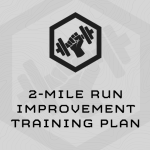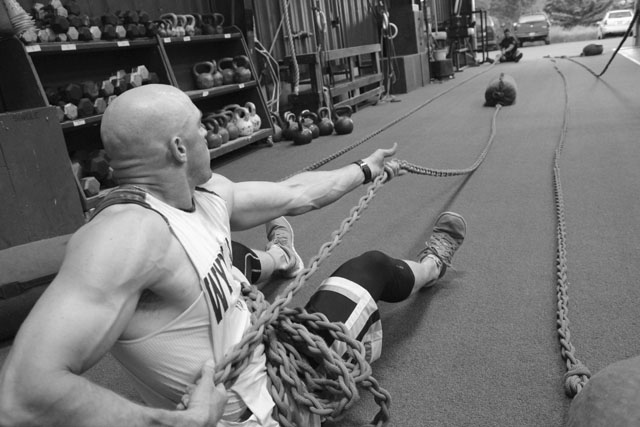QUESTION
I graduate from USMC OCS tomorrow and I want to thank you for the work you do because following your programming allowed me to recover from my broken ankle last summer and perform very well physically at OCS this summer.
Now I’m looking forward to TBS. My TBS date is December 3, 2018 so I have almost 5 months to prepare. I plan on taking a week or 2 off from training and then getting started again. Immediately before TBS I’m going to complete your TBS plan.
Up until then do you recommend any of your plans? Right now I’m 5’10 and about 165lb. My final USMC PFT at OCS was 20 pull-ups, 115 crunches, and 18:52 3 mile. I’m definitely looking to gain some weight and strength.
Any advice you have for me is much appreciated!
ANSWER
Congrats!
– Rob
QUESTION
I’m in my early 30s with a fairly solid history in mountain sports, but am very new to structured training. My primary goal this year is to have a high volume injury-free ski season, but do many other sports throughout the year.
I’m currently working through the Bodyweight Foundation training plan, and was thinking I would next drop into the Greek Heroine series until it was time for one of your Ski plans.
However, I have a very limited strength training background, and I’m sure low relative strength.
Would you recommend doing a strength cycle (TLU or Rat 6) in between Bodyweight Foundation and Greek Heroine series? Or just start in Greek Heroine series, and scale down weight as needed?
ANSWER
– Rob
QUESTION
I live in the mountains of Northern Mexico, I’m a little bit out of shape and looking to get fit again. I’m used to workout at the mountain, mainly doing mountain bike, calisthenics because I practice white-tail hunting and that has worked great for me, it’s not a hard hunt such as the mountain hunts in Western US so I’m a little confused on the training I should choose.
I was thinking of buying the Backcountry Big Game Training Plan and do it all except for the Backcountry Big Game Plan, but which training should I do after completing the first three plans (Bodyweight Foundation, Resilience, Humility)? I’m looking to maintain performance after the three plans.
Thanks for your help, and greetings from Mexico.
ANSWER
These plans apply our programming methodology for general fitness athletes.
– Rob
QUESTION
I have limited equipment and a history of shoulder injuries that are so severe, I’ve been instructed to never do overhead presses again. I’m in reasonably good shape, what program would you recommend I start with. Thank you.
ANSWER
– Rob
QUESTION
Started in the subscription plan and on earlier recommendations from you I started into Ruger. Love the programming so far. One issue I’m running into is the pull-ups. I have severe tendinitis in my elbows. Vertical pulling blows them up. I’ve tried different grips with no relief. I can horizontal row. Should I sub bent rows or
aussie
pull-ups? Is there an adequate substitute?
ANSWER
QUESTION
Back with another question on building mass. A few months ago you recommended to me that I complete the ultimate meathead cycle, and then head back to my LEO/Patrol programming. I am right around the 200lb mark, but I am looking to add more mass. Should I trust the process of building muscle mass through the patrol plans for the time being, or would you recommend using a hypertrophy plan/mass building plan? My goal is to be 210-220. Thank you!
ANSWER
Move back into the LEO/Patrol programming for at least a cycle (7 weeks), then you could repeat
Ultimate Meathead.– Rob
QUESTION
I have a question for you regarding the expedition/preseason ice climbing programs.
A little background: I used your training program for my Denali expedition last year and felt thoroughly prepared. I’m heading back to Alaska next year for some more technical ascents(hopefully), but also want to train to become stronger for ice climbing in general. I am interested in trying your ice climbing programs, my only concern is my limited access to any rock or climbing gyms. There is one small bouldering area in my gym, but I’m not sure I would be able to use my tools there.
So, do you have any suggestions or examples on how to build a training wall/tool for ice climbing?
ANSWER
I don’t have plans – though there are plenty available. It also depends upon your space – how much room you have to build. Best would be a 12×12 wall at a 10-15 degree overhang angle. Check out Moon Climbing. The lower level moon board would work. We use door hinges for ice tool holds. These are metal, and tiny – and won’t let climbers torque far from the direct pull without falling. There are companies which sell ice-specific holds, but these are expensive, and not needed for our programming.
Escape Climbing sells an
ice tool rubber pick which allows ice climbers to use their tools for plastic holds. This way you may be able to use an existing bouldering gym for your tool work.
– Rob
QUESTION
I’m 33 and have become injury prone. It’s always a minor injury but it seems to take months to recover from. I currently have tendinitis in my right foot and have been slowly trying to rehab it for the past two months. I think my biggest issue is general inflexibility (especially in my right leg) and I feel like I need to basically start from scratch with flexibility and stability training before I get back into serious conditioning. I backpack and backcountry hunt so that is my overall focus. Unfortunately every time I try to get going with a workout plan to improve I end up with another minor injury of some sort. While I do have some trips in the next six months, I’m trying to plan and prepare for the long haul. Any advice is welcome, thank you for your time and help.
ANSWER
We believe the key to durability is event-specific fitness. We’re not advocates of stretching, soft tissue work, or any similar activities as a way to build durability. In our experience, these may help with recovery, but their effect on durability pales compared to sport/event-specific fitness.
So I’m not sure what to tell you, other than to say I expect our athletes to train hurt, but not injured. The difference? Training hurt doesn’t make it worse. Training injured can make it worse.
– Rob
QUESTION
I’m a subscribed athlete currently following the Peak Bagger plan for the summer. I’ve been very happy with the results so far. I’m modifying a bit for volume and frequency to allow for continued activities in the mountains while following the plan but it has worked out well.
Ski alpinism
is really my passion. Moderately technical ascents with skis on my back, followed by intricate highly technical and demanding descents is what I really live for in the mountains. In the winter and early spring of
18/19
I have several plans that are going to require
fitness
for ice climbing/alpine climbing followed immediately by very steep, precise skiing. As with most mountain athletes these days, my desire is to move as light and fast as possible to minimize risk and equipment necessary. My stamina is good, but building speed over land is an area of need.
I wanted to get your thoughts on which plan or plans to follow as I transition from the Peak Bagger plan at the end of summer into fall training to be prepared for the ski season? Ideally, I would finish the plan in time for the real start of ski season around Christmas and be in excellent climbing shape around March hoping to retain as much of that peak fitness/readiness through May into June.
Thank you for your time and the excellent resources you have put out there.
ANSWER
– Rob
QUESTION
Looking for a recommendation. I want to start a new plan tomorrow. Little about me. Currently a member of the Army SOF community. 30 years old with a strength background; played D1 football (short NFL contract) as a 300lb lineman. In last years I’ve dropped weight to 225 and have run numerous marathons / IM’s.
I’m currently looking to do an overall balanced program that will continue to work on strength and overall movement, while providing enough capacity / endurance training to complete 12 mile ruck runs
I have completed the Big Mountain, Big 24, CAG Prep plans, RASP Plan and a few others in the past.
Currently I’m trying to decide between Fortitude V2, Hector or Achilles. I would rather do CURTIS P’s than sandbag getups but I’ll leave that to ya’ll.
Let me know what you think and thanks for the great programming.
ANSWER
– Rob
QUESTION
I have extremely bad shoulders and could lose some weight, but I’m in decent shape and active. What program would you recommend I start with. I have limited equipment and I’m interested in general fitness.
ANSWER
QUESTION
What is ya’lls training philosophy in inclement weather? Does it effect you guys at all? For instance, on a rainy day aligned with a long ruck or weighted run day do you all go to an alternative or just drive on and let the shoes and equipment dry later on? or do you all turn to doing a ton of step-ups in lieu?
ANSWER
You’re waterproof. Run/ruck in the rain.
– Rob
QUESTION
I am almost done with the hypertrophy for skinny guys a really great plan I am looking for something to follow next but something that’s a full body strength workout, legs, arms, chest, back shoulders, and core. I am trying to build my strength up as well as staying keeping my endurance and as well as build on it if that makes since. my end state I want to be stronger a little bigger while maintaining my endurance I am not sure what plan to follow next would you happen to have any ideas or point me in the right direction thank you for your time.
ANSWER
I’d recommend
Waylon from our new
Country Singer packet of plans. Waylon is a multi-modal plan which has a slight strength emphasis. Also trained are work capacity, chassis integrity and endurance.
– Rob
QUESTION
Really tempted by the new country singer packet you have released. Want to see what your thoughts are on if it’s right for me.
Background: currently deployed to Afghanistan as an army aviation officer with plenty of gym access. I’m currently finishing week 4 of military on ramp. My original plan was to complete the valor training program.
As an aviation officer I have limited need for loaded endurance (rucking, iba, etc). My main goals are to build and maintain a high level of overall fitness, no particular schools or events down the road.
Any thoughts would be greatly appreciated!
PS: I have the athletes subscription so I have access to all the plans.
ANSWER
– Rob
QUESTION
I am recovering from an injury. I will be testing for law enforcement in Jan 2020. The test is push ups, sit ups, 1.5-mile run. I have not worked out in awhile, and haven’t run in awhile either. I think I would be considered a beginner runner, which would be my worst area. Is there a plan to help me in the areas I need?
ANSWER
– Rob
QUESTION
Hope this message finds you well. I was hoping you could point me in the right direction.
I spent 6 years in the Canadian Army and now I am returning after be away for 11 years. Fun thing is i have to go to basic again and redo my infantry course.
I am pretty good shape. I play competitive rugby and have been lifting for well over 11 years. I have recently been doing the 5/3/1 program and my 2x week rugby training.
I am about two months out before I attend basic. I am looking for program that will keep up my strength between now and when I attend basic and that I would be able to get into right away after 3 months of basic that will best prepare for my Infantry course. At Basic, we mainly will be doing short runs, bodyweight, and prep for a 13k ruck. A little different from when I first attended. Guys have told me that they have lost strength and then struggle while on their infantry course afterward. I will have just about three months between basic and attending the battle school.
I am 36 years of age. 191 lbs.
Any help and direction into which program would work best for my goals ( being the best prepared for battle school) would be greatly appreciated.
ANSWER
I’d recommend
Fortitude. Fortitude combines gym-based strength, with work capacity, military endurance (running, ruck running) and chassis integrity (core).
– Rob
QUESTION
Just checking. I really appreciate MTI’s training and am getting back into it…question though, I understand Rob was working on a Strength program for the “older” generation? Are they finished and/or getting close to releasing it?
ANSWER
– Rob
QUESTION
I’m going to be trying out for the SWAT team 6-8 weeks at my department. I am physically fit when it comes to lifting, but my cardio lacks. I’m running a nine minute mile at the moment and would like to be sub 7:30min. Is this doable in that amount of time? Please advise. Thanks.
ANSWER
Possible? Sure – train and lose some weight.
Understand SWAT Selection is not only running – most units have many other fitness demands. Our
SWAT Selection Training Plan does include focused training for a 1.5 mile run.
QUESTION
I’m trying to decide between Johnny and Humility. I’m a moderately trained athlete currently doing Wendler 5/3/1 and my cardio/work capacity sucks at the moment. I’m not in the military nor LEO, but I do the occasional GORUCK event and like to have a good “base” fitness or general physical preparedness (GPP), with an emphasis on strength. So, is one better than the other, or am I missing the mark entirely and should I go with a different plan?
ANSWER
I’d recommend
Johnny. This is a balanced multi-modal training plan which concurrently trains strength, work capacity, endurance and chassis integrity. It’s a great plan to drop into after your 5/3/1 strength focus.
– Rob
QUESTION
I’m looking to get into law enforcement at the end of next year. I am currently recovering from an injury and haven’t done pt in 6+months. The police test is max push ups/sit ups in a min, 300 meter run,and 1.5 mile run. The 300 meter in less than 71 seconds, 1.5 in 14:31 or less. I guess I would be considered a fitness beginner. I need a program that will build me back up,and focus on the events I need. My main issue will be running, I’ll need a good plan with a good run focus. Please help me choose.
ANSWER
Subscribe to MTI's Newsletter - BETA









